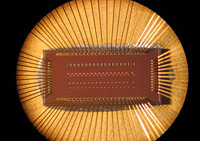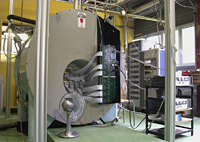 |
|||||||||||
|
|||||||||||
|
|||||||||||
One of the main French contributions is the electromagnetic calorimeter (ECAL), within the CALICE (Calorimeter for the Linear Collider with Electrons) international collaboration. Recently, some effort has also been directed towards another calorimeter collaboration. Another important study is on microvertex detectors based on CMOS technology (Complementary Metal-Oxide Semiconductor). R&D to improve charged particle tracking is also pursued within the SiLC (Silicon tracker for the Linear Collider) and LC-TPC (Time Projection Chamber) international collaborations. Within CALICE, an ECAL prototype (see picture 1) has been realized and tested in a beam at DESY to validate mechanical and electronic choices. Concerning microvertex detectors (the closest to the interaction point), an activity is ongoing on Monolithic Active Pixel Sensors (MAPS). These are promising high speed, precise, low mass and low power devices The French effort is concentrated in achieving fast pixel CMOS sensors and in integrating the signal processing. The French activities in SiLC are devoted to developing a front-end chip in very deep sub-micron CMOS technology as well as sensors and mechanics. A first prototype in 180 nanometer CMOS technology was successfully built and tested (see picture 2). Combined tests with other sub-detector prototypes are also foreseen. The Micromegas (MICRO-MEsh GASeous detector) Saclay-Orsay-Berkeley TPC has been tested with cosmics at Saclay (see picture 3). Other Micromegas TPCs have also been tested in a pion beam at KEK in 2005, with the participation of French teams at Orsay and Saclay. A very good spatial resolution - better than 50 microns - was obtained. A realistic and flexible detector simulation is needed for optimisation. In France, the contribution to these developments is a priority. Most of the software is based on GEANT4 and has the advantage of being versatile. This allows comparing different ILC Detector Concepts. The flexibility of the geometry description offered by these packages is a key point to perform the detector optimisation in a parametric way. Nearly all sub-detectors can be simulated like calorimeters, TPC, MicroVertex and silicon trackers. GEANT4 is also used to simulate beam-induced backgrounds in the detectors, and an interface to the detector simulation is provided. The communication between software tools has been improved a lot with the elaboration of a common format for the data structure. Although the reconstruction algorithms are still being developed, a full simulation chain has already been started to carry through the analyses of the most critical physics channels. French activities are funded both nationally (IN2P3 and DAPNIA) and at the European level, because R&D is also supported by the EUDET European contract (see NewsLine 8 September 2005). Nearly all French laboratories are involved in ILC detector R&D. This ILC R&D is important for the institutes to maintain and develop the expertise gained during the preparation of the LHC. During this meeting, the Institute of Nuclear Physics of Lyon (IPNL) showed strong interest in the ILC and presented a proposal for electronics R&D. SOCLE meetings are usually held twice a year. As a tradition, a foreign scientist interested in the ILC is always invited to speak at the meeting. At the last seminar, Shaomin Chen, a physicist from Tsinghua University, presented the Chinese HEP programme. The collaboration with the HEP community in Asia was also emphasised by François Le Diberder, deputy director of IN2P3 for particle physics. During the meeting, he announced the creation of a Franco-Japanese Associated International Laboratory (LIA) which will fund travels for both communities. The seminar was also an opportunity for young PhD or post-doctoral researchers to present their work and participate in the discussions of the future plans. This is not often possible in a large community like the ILC. --Perrine Royole-Degieux |
|||||||||||
| © International Linear Collider |



